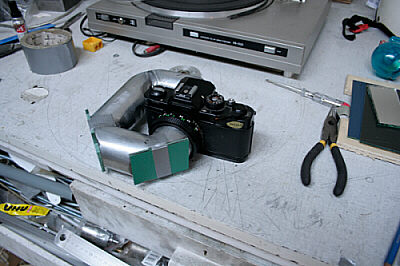fieldOfView
( Steven Pippin )
Pippin, has long been interested in investigating the photographic process; during his career he has turned refrigerators, bathrooms, even entire houses into cameras. To transform the 12 Wascomat Senior Triple Loader washing machines into cameras, he hand-cut circular pieces of film and fashioned lenses to fit over the thick glass windows. His subjects walked by the machines/cameras, hitting trip wires installed in front of each machine. Once the photos were taken, Pippin processed the film inside the washers, pouring in Kodak Decktol developer and fixer instead of Tide.
The photos—circular images of a man walking by with an erection, a naked woman, a horse and rider—are scratched, inconsistently focused, in some instances totally black. They seem old almost, like relics from when photography was a new medium—which seems apt, since the project is in part an homage to 19th-century photographer Eadward Muybridge, whose famous studies of animal and human locomotion at the University of Pennsylvania and in San Francisco laid the groundwork for motion pictures.
While Pippin's photographs are, like Muybridge's, a study of movement, his interests aren't exactly scientific. He's more concerned with recapturing the sense of wonder inherent in photography.
He also once turned an enamel bathtub into a camera. He loaded film into the tub and completely covered the top, except for a tiny pinprick in the center. He undressed, and balanced himself on the tub's rim for the duration of the 90-minute exposure.
If a bathtub could become a camera, why not a public toilet? Pippin, who studied mechanical engineering and sculpture, once sneaked into a tiny lavatory on a British Railways train on its way from London to Brighton, and set up shop. "It had everything to not only take a picture, but to process it as well," he says. "And it was all in this private room, this cubicle, so it's almost like a photo booth."
In 1989, he created Launderama (Ipso Facto), which was essentially a nine-minute film of a washing machine going through a complete cycle, shot from the outside. When he finished filming, he processed the film in the washer.
"I like the idea that this would give you a film which somehow was not only looking at the image, but also the experience of being inside the image," he says. "[The process] was a complete closed loop."

_____________________________________


